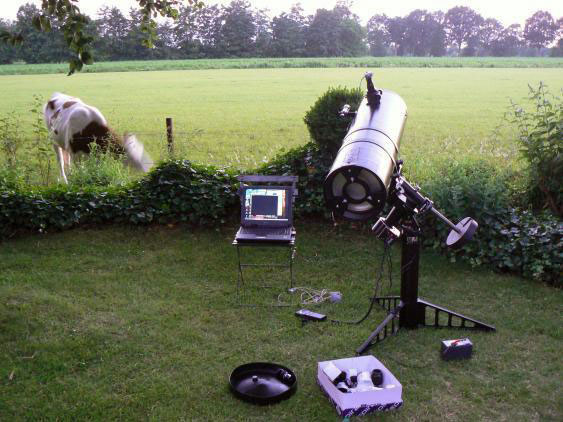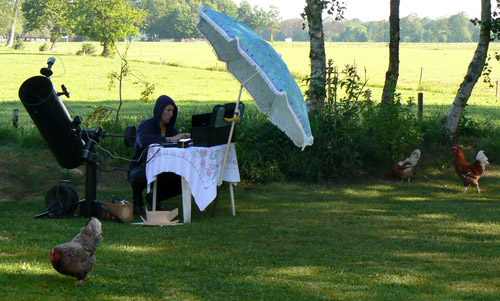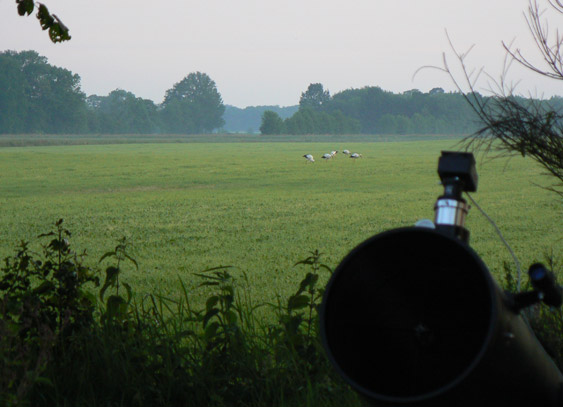ZWO ASI290MM
Extremely low read noise (1.0e!) planetary camera from ZWO. 2.9um pixels, 2MP, 170fps.
Extremely low read noise (1.0e!) planetary camera from ZWO. 2.9um pixels, 2MP, 170fps.
Cooled extremely low read noise (1.2e!) deepsky camera from ZWO. Can probably do pretty good planetary as well.
Very sensitive (QE around 80% at 525nm) and low noise (+- 4e at high gain) monochrome camera with 5.76um pixels (1920x1200). The IMX249 sensor is however slower (41 fps at full frame) than his big brother, the IMX174. I have the GigE version, but the speed isn't limited by the interface, but by the sensor. The camera is rather small, and therefore runs quite hot, very short exposure deepsky imaging is possible though.
Uncooled (planetary) imaging camera. Read noise is 1.5e at 0dB, and 0.75e at 20dB! Interesting for low-light imaging, especially deepsky. Small pixels though (3.75um) and color only.
Uncooled (planetary) imaging camera. 1936x1216 @ 128fps, 640x480 @ 309fps. +- 6.5e read noise at 0dB gain, 3.8e at 20dB gain. Similar to the ASI120MM, but due to no fixed pattern noise and faster FPS, this is my new camera of choice (also for deepsky it shall be interesting!)
Uncooled (planetary) imaging camera. 1280x960 @ 30fps, 640x480 @ 80fps. Noise characteristics are good, and sensitivity is very much comparable to the icx618ala sensors. This is my new planetary camera of choice.
A homemade telescope with superb optics. I was able to play around with this telescope for 1.5 years, before I pulled the trigger and bought it.
The Ace is my new planetary camera: the modified DMK21 performed very well, but has been sold. The ace is a GigE camera and a bit more difficult to use, but it does have a lot more potential (12-bit, 120fps at full resolution)

This is my main telescope (since April 2007, second hand).
The telescope came with a Magellan II push-to controller, including the tangent-arm hardware that enables electronic control of the telescope in Declination. This is very handy for making quick corrections during planetary imaging (especially when the scope is not properly polar aligned), but the Magellan II is not capable of autoguiding or PEC. Because of the large periodic error of the mount (about 50 arcseconds and very erratic!) exposures longer than 10 to 20 seconds are simply not possible.

Even at 10 second exposures more than half of the images have to be discarded due to blurry stars or star trails. My solution to this problem is to shoot as many images as possible, and manually select the best of them when imaging is done. In my case shorter exposure times also mean sharper images, and if I can get enough light in 5 seconds, then it's usually better to shoot 100 x 5 second images instead of 50 x 10 second images.
Some small modifications have been made to this telescope. A new basic crayford focuser and a home-made electric focusser has been installed to make fine focussing much easier. I found this to be crucial especially for planetary imaging. Being able to look at the laptop screen and get instant results of the focusing process saves a lot of time and is also much more accurate. The mount, focuser and aircooling of the webcams all run on an old computer power supply. The entire setup is not very portable, but I can set it up in about 10 minutes time.
Because of the fast focal ratio of the telescope I usually use a 5x Powermate for planetary imaging to get up to about F/32. The powermate operates at about 7.2x because of the long distance between the ccd and the powermate (there is a filterwheel in between). Collimation is important (especially for such a fast telescope, F/4.5), and I use a barlowed (2x) laser collimator to align the optics before every imaging session, and sometimes in between the imaging sessions.

The image above shows a, more or less, typical imaging session. Here I'm trying to get some descent images of Venus (I failed...). Usually the telescope is located on the other side of the house where I placed several large and heavy square tiles with markings on them to get a fast polar alignment.
Some time ago I got another set of marked tiles providing me with a better view of the area around Polaris. I just discovered the enormous advantages of imaging in this area: tracking becomes less of a problem (altough polar alignment has to be really good!), so I can up my exposure times, but still not higher than 15 seconds. And/or I can keep about 90% of my light-frames at 70 degrees decilnation instead of only 20% when imaging at 0 degrees declination!

As of early 2010 I'm pretty much focusing all of my astronomy attention on planetary imaging. Occasionaly I still record a deepsky object, but I find it a lot more rewarding to make images of objects within our solar system. In the future I will probably make more images of deepsky objects again, but I would first want to get my hand on a completely new setup before that will happen (mount, scope, camera...).
The icx618 ccds are much more sensitive to light than the previous icx098 ccds
A very nice astronomical imaging camera, definately worth the money as far as I'm concerned; although the 60fps causes ghost images, imaging at 30fps (uncompressed!) is still very nice. It is much, much better than the mono Toucam camera at capturing planetary images. Deepsky is also possible, but the tiny pixels limit the possibilities.
The camera will be main camera to get color information from deepsky objects. It has aircooling installed and the webcam was placed in a new housing.
This webcam is air-cooled and modified for long exposure. A black and white ccd sensor, the ICX098BL-E, has also been installed.
This webcam is not working anymore, but some images on this site were created using this webcam.
The webcam is air-cooled and modified for long exposure.
A larger black and white ccd sensor, the ICX424AL-E, has also been installed. An amp-off mod has not been installed, and amp-glow is a bit of a problem with this webcam, but it can still produce very good images.
The biggest advantage of this camera is the somewhat larger pixel size of the 424 CCD compared to an 098 CCD, and the camera is therefore a little less sensitive to the effects of the periodic error and mount stability issues. The field of view of the camera is also slightly larger.
The webcam is air-cooled and modified for long exposure.
This is the only colour webcam I have. It's used for planetary imaging as well as deepsky imaging, but since the b/w webcams are more sensitive I always use those to get the luminance data.
Edit; The long-exposure and amp-off mod have been removed. This camera is currently only used for planetary images.
The webcam is air-cooled and modified for long exposure and has an amp-off mod installed (SC1.5). A black and white CCD sensor, the ICX098BL-E, replaced the original colour CCD.
This is my main planetary webcam. I can take 10fps frames without too much compression artifacts (5 fps would be even better, but there is a trade-off between getting as many frames as possible, and low compression. I found 10 fps to work best). I have taken some deepsky images with this camera (it actually is really good at it), but the sensitivity and slightly larger FOV of the 680k webcam is just too good not to use that one, even though the ccd of 680k is slightly damaged and has a huge amp-glow!